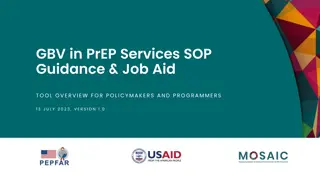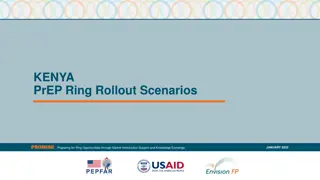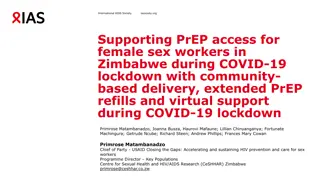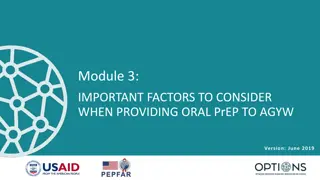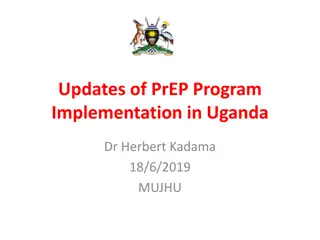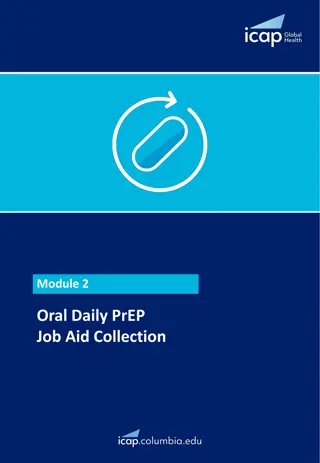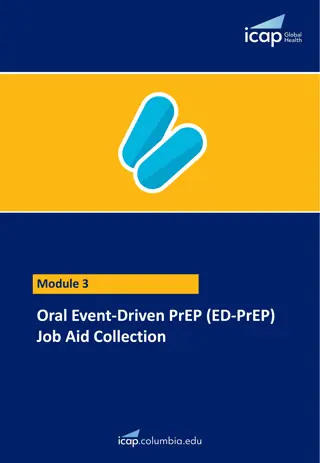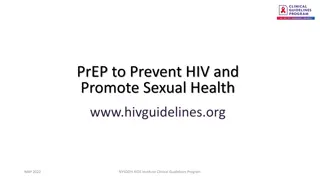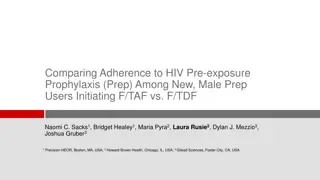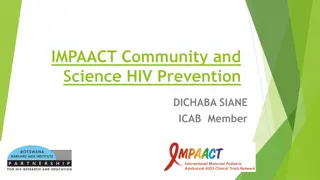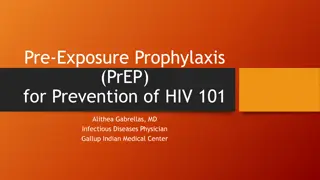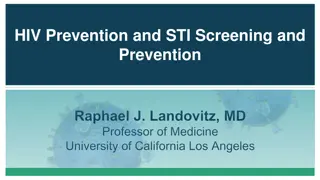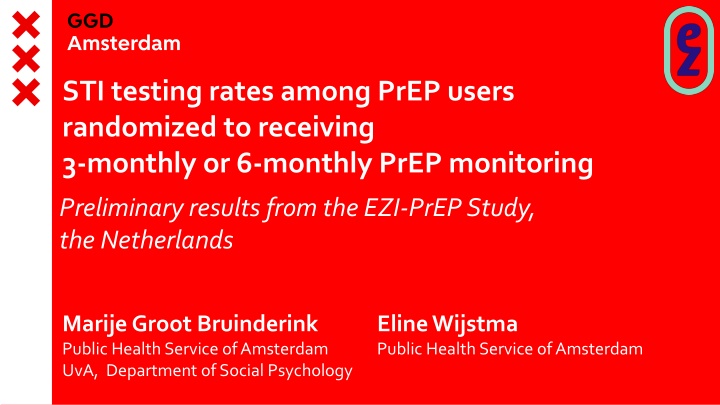
STI Testing Rates Among PrEP Users: EZI-PrEP Study in the Netherlands
Preliminary results from the EZI-PrEP Study in the Netherlands focus on the STI testing rates among PrEP users randomized to receiving 3-monthly or 6-monthly PrEP monitoring. The study aims to increase access to PrEP, comparing Online PrEP monitoring with in-clinic monitoring and evaluating the impact on unprotected acts. With primary and secondary objectives outlined, the study design involves a Randomized Controlled Non-Inferiority Trial with four study arms implemented within the National PrEP Pilot in the Netherlands. The participants included MSM and transgender individuals meeting specific eligibility criteria. Results are expected in 2024.
Download Presentation

Please find below an Image/Link to download the presentation.
The content on the website is provided AS IS for your information and personal use only. It may not be sold, licensed, or shared on other websites without obtaining consent from the author. If you encounter any issues during the download, it is possible that the publisher has removed the file from their server.
You are allowed to download the files provided on this website for personal or commercial use, subject to the condition that they are used lawfully. All files are the property of their respective owners.
The content on the website is provided AS IS for your information and personal use only. It may not be sold, licensed, or shared on other websites without obtaining consent from the author.
E N D
Presentation Transcript
STI testing rates among PrEP users randomized to receiving 3-monthly or 6-monthly PrEP monitoring Preliminary results from the EZI-PrEP Study, the Netherlands Marije Groot Bruinderink Public Health Service of Amsterdam UvA, Department of Social Psychology Eline Wijstma Public Health Service of Amsterdam
Disclosure of speakers interests Nothing to disclose
Aims of the EZI-PrEP study Aim: increasing easy access to PrEP How: implementing and evaluating the following PrEP provision modalities: Online PrEP monitoring trajectory 6-monthly PrEP monitoring schedule
Primary objectives To establish non-inferiority of: Online PrEP monitoring versus in-clinic PrEP monitoring Monitoring visits every 6 months versus every 3 months Primary outcome measure: Days with unprotected acts (UA) UA = casual anal sex act not covered by condoms or PrEP Measured with daily diary data Results are expected in 2024
Secondary objective To investigate differences between PrEP monitoring every 6 months and every 3 months on: The total number of visits, PrEP visits, in-between STI test visits STI positivity at these visits Preliminary findings in this presentation Final results are expected in 2024
Design of the EZI-PrEP Study Randomized Controlled Non-Inferiority Trial 4 study arms: 1. In-clinic PrEP monitoring, every 3 months 2. In-clinic PrEP monitoring, every 6 months 3. Online PrEP monitoring, every 3 months 4. Online PrEP monitoring, every 6 months Implemented within National PrEP Pilot in the Netherlands (2019-2024) 4 study sites: Sexual Health Centers in Amsterdam, Rotterdam, The Hague and Nijmegen
EZI-PrEP participants 469 participants included (Sept. 2021 July 2022) Most important inclusion criteria: MSM and transgender and gender-diverse persons Fullfills eligibility criteria for PrEP care NPP 18 years or older Smartphone with IOS or Android Able to complete online bank transactions Speaks sufficient English or Dutch
Methods data Dutch national SHC surveillance database ( SOAP data ) September 2021 untilSeptember 2023 Data included: Participants with at least 1 PrEP follow-up visit after inclusion Study sites: Amsterdam, Rotterdam-Rijnmond and The Hague
Methods variables and statistics (1) Calculated per PrEP monitoring frequency (3-monthly, 6-monthly): Overall visit rate: total number of PrEP visits and in-between STI test visits, per py In-between STI test visit rate: number of in-between STI test visits, per py Compared visit rates between monitoring frequency using visit rate ratio
Methods variables and statistics (2) Positivity of any bacterial STI (chlamydia, gonorrhea, or infectious syphilis): number of visits with a positive STI test / number of visits 2test to compare positivity between monitoring frequencies
Results 428 participant (out of 439 included at 3 sites) 215participants receiving PrEP monitoring every 3 months 213 participants receiving PrEP monitoring every 6 months 512 person-years of follow up
No. of PrEP monitoring visits and in-between STI test visits Sept. 2021 Sept. 2023 1400 1200 146 Total number of visits 1000 No. of in-between STI test visits No. of PrEP visits 800 264 600 1085 400 538 200 0 Every 3 mo Every 6 mo
Results incidence rates of visits PrEP monitoring every 3 months PrEP monitoring every 6 months P IR of any visit per py[95% CI] 4.6 3.3 <0.0001 [4.4-4.9] [3.0-3.5] IR of in-between visits per py [95% CI] 0.55 1.07 <0.0001 [0.47-0.65] [0.95-1.21]
STI positivity by monitoring frequency Sept. 2021 and Sept. 2023, per visit type 100% 90% Visits with positive STI test 80% 70% 60% Every 3 months Every 6 months 50% 40% 30% 20% 37% 30% 22% 10% 21% 19% 18% 0% All visits PrEP visits In-between visits
Conclusions Monitoring every 6 months leads to: Fewer scheduled PrEP monitoring visits More in-between STI test visits Fewer overall visits STI positivity similar in the two monitoring frequency groups Higher proportion positive tests at in-between STI test visits in 3-monthly monitoring group
Next steps.. Use full EZI-PrEP dataset: Participants from SHC Nijmegen Data until completion of 18 month PrEP visit Data from questionnaires on STI testing at facility other than SHC Additional analyses on STI incidence Final results are expected in 2024
Acknowledgements (1) Principal investigators: Maarten F. Schim van der Loeff1,2, Udi Davidovich1,3 EZI-PrEP Trial Participants Participants group discussions Other involved researchers: Elske Hoornenborg1,2, Frenk van Harreveld3,4 Allard Feddes3, Hannelore M. G tz5,6 , Vita W. Jongen1,7, Liza Coyer1 , Maria Prins1,2 Anders Boyd1,7, Amy Matser1,Lotte Werner1 , Maaike Soors d Ancona1, KoenraadVermey8 Funding from: Affiliations: 1 Public Health Service of Amsterdam, Dpt. of Infectious Diseases, Amsterdam, The Netherlands; 2 Amsterdam UMC, University of Amsterdam, Dpt. of Infectious Diseases, Amsterdam Institute for Infection & Immunity (AII), Amsterdam, The Netherlands; 3 University of Amsterdam, Dpt. of Psychology, Amsterdam, The Netherlands; 4 National Institute for Public Health and the Environment (RIVM), Bilthoven, The Netherlands; 5 Public Health Service of Rotterdam-Rijnmond, Dpt. of Infectious Diseases, Rotterdam, The Netherlands; 6 Dpt. of Public Health, Erasmus MC, University Medical Center, Rotterdam, Netherlands 7 HIV Monitoring Foundation, Amsterdam, The Netherlands; 8 STI AIDS, The Netherlands StichtingAidsfonds-SoaAids Nederland: project numbers: P-42701 and P- 54201. Gilead Sciences: Grant ID Number: 21341 GGD Amsterdam: project numbers: 2021-5 and 2022-2
Acknowledgements (2) EZI-PrEP teams at study sites: EZI-PrEP teams at study sites: GGD Rotterdam-Rijnmond: Sophie Boers (study physician), Maudy Sluimer (study nurse), Charelle Zwiggelaar, Marianne Kerpershoek, Mieke Illidge, Martijn Stip GGD Amsterdam: Joey Woudstra (data manager), Kenneth Yap (study physician), Abdullah Aksoy (study nurse), Dennis Heineman, Arjan Bril, Francine van den Heuvel, VinhiNguyen. GGD Gelderland-Zuid: Alexander Sangers (study nurse), Colette van Bokhoven-Rombouts (study physician), Daphne Sassen, Sarah Brevet, Patrick Dielissen, Sophie Boers GGD Haaglanden: Jean-Marie Brand (study physician), Laura Blitz (study nurse), Emma van de Ven, Ren e Cieraad
Acknowledgements (3) Members of EZI-PrEP advisory board: Bea Vuylsteke, Marc van der Valk, David Burger, Hanna Bos, Chris Tearno, Jan den Hollander, John de Wit, Janny Dekker, Kai Jonas, Silke David, Sebastiaan Verboeket, Janneke van de Wijgert, Paul Zantkuijl Implementing partners: RIVM: Birgit van Benthem, Danja Sarink, Silke David DC Apotheek Amsterdam: Rosalie Zieck and Laurens Maussen IT4Care, PHS Amsterdam: Frank Mouthaan and Liesbeth Flobbe Man tot Man and Soa Aids Nederland: Arjan van Beijnen and Wim Zuilhof Streeklaboratorium Amsterdam: Margreet Visser, Ren Vork, Wilma Vermeulen-Oost, Trevor de Waal, Sylvia Bruisten Clinical Monitoring Center (CMC), AUMC: GerritJan Ilbrink Innovattic, digital agency Current and former colleagues at EZI-PrEP study sites: Ilya Peeters, Bart-Jan Mulder, Roelien Prins, Marjolein Booij, Astrid van der Wal, Lisa Boode, Robert Pol ek, Anja in t Veld, Kees van Gelderen, Maarten van Haagen, Karin Tang, Ertan Ersan, Dominique Loomans, Titia Heijman, Janneke Bil,Amber Hof, Remy Welleman, Sophie Kuizenga Wessel, Jeannine Hautvast, Fokke Postma and Fetzen de Groot

